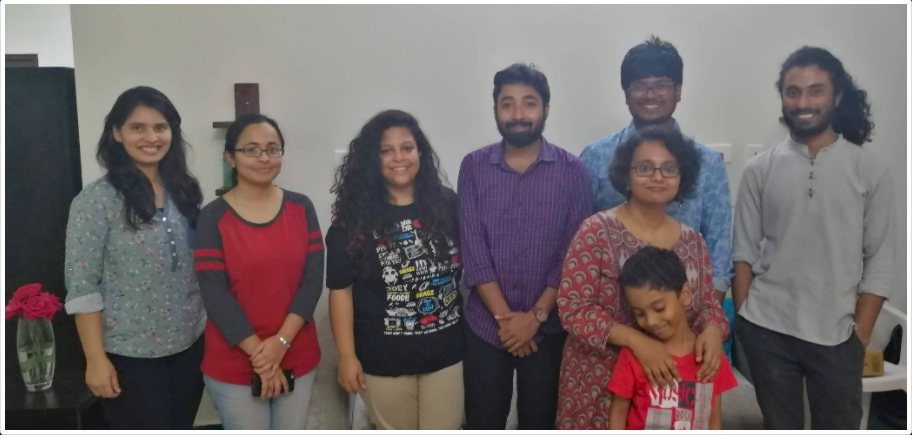Dr. Koel Das: Into thoughts and beyond
WIISER : Women in Science at IISER
Leafy Behera and Arunita Banerjee

Dr. Koel Das is an Associate Professor in the Department of Mathematics and Statistics, at IISER Kolkata. In this electronic interview, she talks about her transition from an engineering background into academic research and her views on gender-balance renewal in research fields.
Tweet
1. Please describe your academic journey, transitioning from electrical engineering to cognitive neuroscience.
I did my Bachelors and Masters in Electrical Engineering and my Ph.D. in Electrical and Computer Engineering. During my Ph.D., I started working on neural signal processing and classification for large-scale data, which was the foundation for my interest in Cognitive Neuroscience. My Ph.D. research was mainly focused on designing algorithms for exploring neural data for the Brain-Computer Interface. Towards the end of my doctoral process, I decided to pursue Cognitive Neuroscience and wanted to get some hands-on experience in designing experiments and exploring neural data using EEG (electroencephalogram) and fMRI (functional magnetic resonance imaging) techniques. I wanted a career in academics and in order to make myself self-sufficient, gaining expertise in cognitive experiments was necessary. Hence for my postdoctoral research, I joined a lab that works on visual search and used EEG, fMRI, and eye-tracking methods. My postdoctoral research experience was key to my future research in cognitive neuroscience once I returned to India and joined IISER Kolkata.
2. Being in an interdisciplinary field requires you to cross various boundaries to put together your research. How would you describe your work in layman's terms? What questions interested you to delve deeper into this field?
My work mainly focuses on understanding perceptual decision-making and factors affecting our decision. For example, while we are walking around the campus, how do we detect snakes or other dangers lurking around? What are the factors (like daytime, time of the year, and others) that aid or abate our target detection skills? How can we improve our target detection (e.g., taking a companion while walking so that two heads are better than one)?
We have also recently started exploring food cravings and trying to understand the concept of craving in an Indian setup.
We design experiments usually by showing images to our volunteers on the computer screen and asking them to perform certain cognitive tasks that fulfill our objective. We record their brain signals using EEG and analyze them to understand the underlying neural dynamics.
We also perform behavioral data analysis of the same tasks and use statistical models to explain our behavioral response to the tasks. A large part of our research also involves designing novel algorithms and methods that can be used for analyzing noisy brain signals.
3. Since cognitive neuroscience is comparatively a new and emerging field of research in India, it has suffered a huge brain drain in the last decade. According to you, how can we improve collaborative efforts and develop a stronger scientific network in this field?
There should be both formal and informal get-togethers of the few cogneuro labs that are currently present in India. There are a couple of national and international workshops and conferences that are organized intermittently but the number should be much higher.
At the same time, it has also brought about open discussions on lesser talked topics such as workplace discrimination, harassment, etc. Organizations are now more sensitive to these issues and steps are being taken in the right direction to ensure a better working environment for women in academia. We have a long way to go to bring things to their ideal conditions, but we are working towards these positively.
4. What would be your word of advice to someone who wants to pursue cognitive science research and build a career in this niche?
It is important to figure out the broad area that interests you and accordingly, you must gain expertise and knowledge in that area of research. Experience in both biological and computational skills is becoming an essential requirement in the field, and research experience in both will help you secure a good position both in India and abroad.
5. What is your take on women's participation in neuroscience or STEM fields in general? How do you think we could refine the system to improve the visibility of women in these domains?
Women’s participation in neuroscience and/or STEM fields is quite low and needs to improve at a higher rate than what is happening currently. I feel that more female administrators/scientists should be in positions of power that enable them to frame and implement female-friendly policies.
This electronic interview was coordinated and conducted by Leafy Behera and Arunita Banerjee for Cogito137.
Leafy is currently a third-year BS-MS student at IISER Kolkata, majoring in biological science. She intends to study cognitive science and understand how decisions are made on the neural circuit level.
signup with your email to get the latest articles instantly